Selected
Takao 599 museum has all kinds of animals inhabit in Mt. Takao in various ways of exhibitions such as seasonal wild plants preserved in acrylic and all kinds of animals specimens inhibits in Mt. Takao. On the "NATURE WALL," stuffed animals are displayed and shows the movie to introduce the dynamic nature of Mt. Takao.
-
Cettia squameiceps (Short-tailed Bush Warbler) Cettiidae
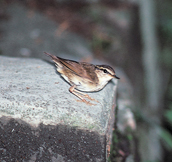
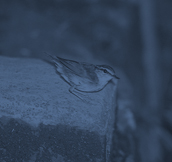 Cettia squameiceps (Short-tailed Bush Warbler) Cettiidae
Cettia squameiceps (Short-tailed Bush Warbler) Cettiidae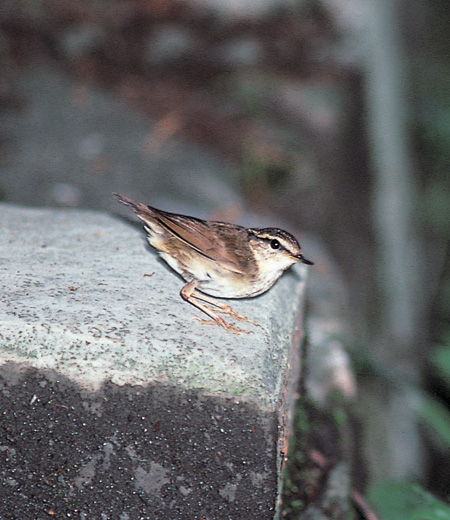 Fly back to Japan in spring from Southeast Asia where they spent winter. It is difficult to find as they live in shady forests with sasa leaves and hardly ever come out from there. Live alone except breeding season and walk and jump around to hunt for bugs and spiders just like rats do. The body color of male and female is almost the same with brown body, cocoon like white belt-like patterns and have short tail. The breeding season is from May to July and male chirp sounding like ”shin shin shin” like insects and for alerting, “cha cha” in own territory. Build a cup-shaped nest with moss and fallen leaves at the roots of trees and dip on the ground and lay five to seven eggs in a season. In autumn after nestling, fly to south.
Fly back to Japan in spring from Southeast Asia where they spent winter. It is difficult to find as they live in shady forests with sasa leaves and hardly ever come out from there. Live alone except breeding season and walk and jump around to hunt for bugs and spiders just like rats do. The body color of male and female is almost the same with brown body, cocoon like white belt-like patterns and have short tail. The breeding season is from May to July and male chirp sounding like ”shin shin shin” like insects and for alerting, “cha cha” in own territory. Build a cup-shaped nest with moss and fallen leaves at the roots of trees and dip on the ground and lay five to seven eggs in a season. In autumn after nestling, fly to south.
●Body Length about 11 cm
●Season April to September (Summer bird, fly to one area from spring to summer for breeding and fly back to southern areas in autumn) -
Aegithalos caudatus (Long-tailed Tit) Aegithalidae
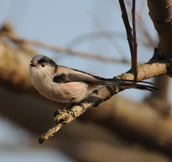
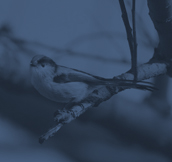 Aegithalos caudatus (Long-tailed Tit) Aegithalidae
Aegithalos caudatus (Long-tailed Tit) Aegithalidae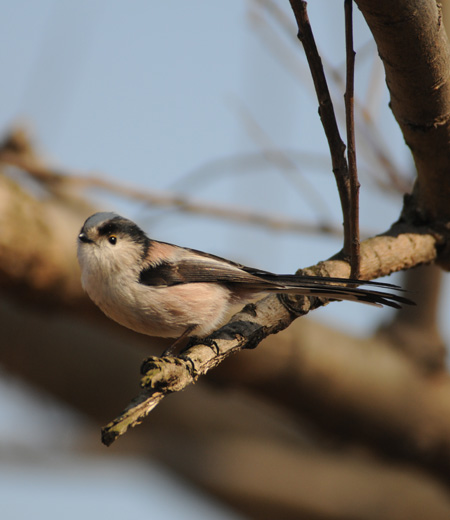 This species have the shortest bill in Japan. Have a small roundy body with distinct long tail. The body color of male and female is almost the same, white head with black belt above eyes and light purple color on shoulders. Live in pine tree forests from flatlands to mountains and also in woody residential areas and at parks. Chirp sounding like “ju li ju li tu li li chee chee” regardless of season. Live in a small group except breeding season and some are with other birds such as great tit. Feed on bugs, spiders and nuts of trees on branches and also on sap of maple trees in early spring. The breeding season is from February to June. Build a oval-shaped nest with twigs, spider’s thread and moss and lay seven to twelve eggs in a season.
This species have the shortest bill in Japan. Have a small roundy body with distinct long tail. The body color of male and female is almost the same, white head with black belt above eyes and light purple color on shoulders. Live in pine tree forests from flatlands to mountains and also in woody residential areas and at parks. Chirp sounding like “ju li ju li tu li li chee chee” regardless of season. Live in a small group except breeding season and some are with other birds such as great tit. Feed on bugs, spiders and nuts of trees on branches and also on sap of maple trees in early spring. The breeding season is from February to June. Build a oval-shaped nest with twigs, spider’s thread and moss and lay seven to twelve eggs in a season.
●Body Length about 14 cm
●Season January to December (resident bird, bird that stay in the same area all year round.) -
Phylloscopus occipitalis (Crowned Willow Warbler) Phylloscopidae
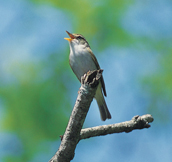
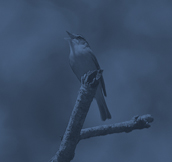 Phylloscopus occipitalis (Crowned Willow Warbler) Phylloscopidae
Phylloscopus occipitalis (Crowned Willow Warbler) Phylloscopidae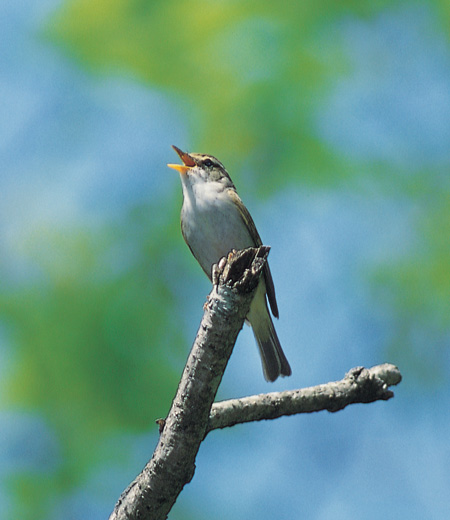 Fly back to Japan in spring from Southeast Asia where they spent winter. Live in broad-leaved forests including quercus serrate and maple trees in low elevations but found them at parks and residential areas from spring and autumn. The body color of male and female is almost the same and dark green from head to back with white cocoon like long line. Move frequently on branches and feed on bugs and spiders on leaves and branches. The breeding season is May to June and chirp sounding like “cho cho bee” on trees, also sounding like “sho-chu-ippai-gubi” in Japanese (one more cup of shochu). Build a ball-shaped nest with the entrance is tilted open by collecting fallen leaves and plants. Lay five to six eggs in a season.
Fly back to Japan in spring from Southeast Asia where they spent winter. Live in broad-leaved forests including quercus serrate and maple trees in low elevations but found them at parks and residential areas from spring and autumn. The body color of male and female is almost the same and dark green from head to back with white cocoon like long line. Move frequently on branches and feed on bugs and spiders on leaves and branches. The breeding season is May to June and chirp sounding like “cho cho bee” on trees, also sounding like “sho-chu-ippai-gubi” in Japanese (one more cup of shochu). Build a ball-shaped nest with the entrance is tilted open by collecting fallen leaves and plants. Lay five to six eggs in a season.
●Body Length about 13 cm
●Season April to September (Summer bird, fly to one area from spring to summer for breeding and fly back to southern areas in autumn.) -
Zosterops japonica (Japanese White-eye) Zosteropidae
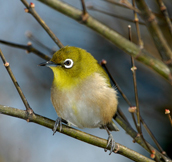
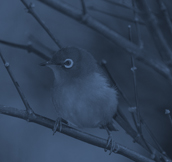 Zosterops japonica (Japanese White-eye) Zosteropidae
Zosterops japonica (Japanese White-eye) Zosteropidae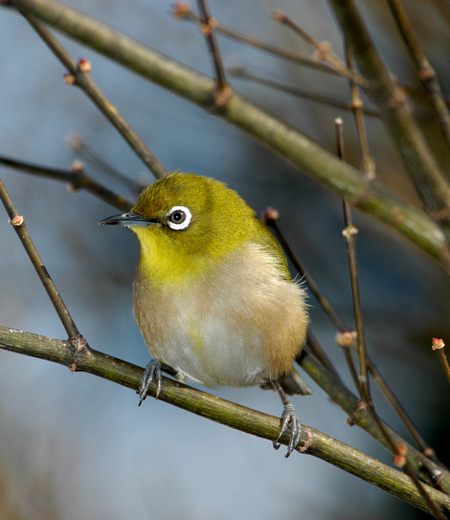 Found in forests from flatlands to low elevations and also at parks, gardens and backyards of residence. The body color of male and female is almost the same and have yellow-green from head to the back and distinct ring of white feathers around eyes. Most of them live in pairs throughout a year and move frequently among trees and hunt for spiders and plant louses. Also likes nectar and pollen of flowers and fly to camellia, cherry blossoms and Japanese ume flowers for nectar and pollen. At these tree, the face of this species are covered with pollen, thus they have the role of pollinating. The breeding season is from April to June. Build a cup-shaped nest with moss and stems of plants glued with spider’s threads. Lay three to five eggs in a season.
Found in forests from flatlands to low elevations and also at parks, gardens and backyards of residence. The body color of male and female is almost the same and have yellow-green from head to the back and distinct ring of white feathers around eyes. Most of them live in pairs throughout a year and move frequently among trees and hunt for spiders and plant louses. Also likes nectar and pollen of flowers and fly to camellia, cherry blossoms and Japanese ume flowers for nectar and pollen. At these tree, the face of this species are covered with pollen, thus they have the role of pollinating. The breeding season is from April to June. Build a cup-shaped nest with moss and stems of plants glued with spider’s threads. Lay three to five eggs in a season.
●Body Length about 12 cm
●Season January to December (resident bird, bird that stay in the same area all year round.) -
Bombycilla japonica (Japanese Waxwing) Bombycillidae
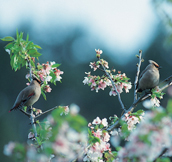
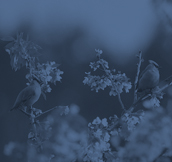 Bombycilla japonica (Japanese Waxwing) Bombycillidae
Bombycilla japonica (Japanese Waxwing) Bombycillidae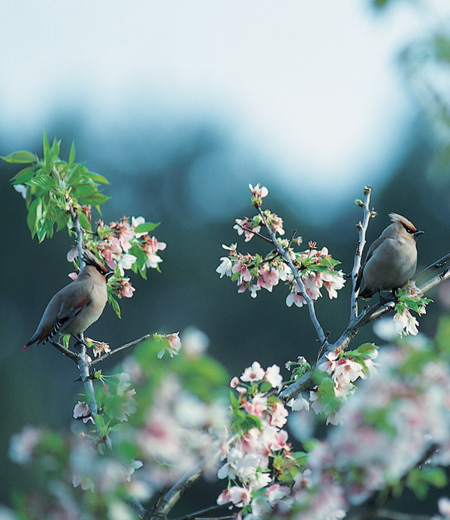 Come back to Japan around October from breeding ground in Siberia to spent winter. Found in forests in low elevations and at parks in cities. Is very similar to waxwing with reddish brown body with crown-like feathers on the head. Chirp sounding like a bell “tinkle tinkle tinkle”. The point to identify this species from waxwing is the body size. This species is slightly smaller and have red belt-like pattern on tail. Are always in a group and rest in one tree or lining up on electric wires and fly altogether. Feed on nuts of trees but some catches insects during flight. Fly back to the north before summer.
Come back to Japan around October from breeding ground in Siberia to spent winter. Found in forests in low elevations and at parks in cities. Is very similar to waxwing with reddish brown body with crown-like feathers on the head. Chirp sounding like a bell “tinkle tinkle tinkle”. The point to identify this species from waxwing is the body size. This species is slightly smaller and have red belt-like pattern on tail. Are always in a group and rest in one tree or lining up on electric wires and fly altogether. Feed on nuts of trees but some catches insects during flight. Fly back to the north before summer.
●Body Length about 18 cm
●Season October to about May (winter bird) -
Turdus pallidus (Pale Thrush) Turdidae
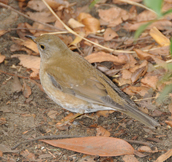
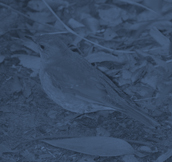 Turdus pallidus (Pale Thrush) Turdidae
Turdus pallidus (Pale Thrush) Turdidae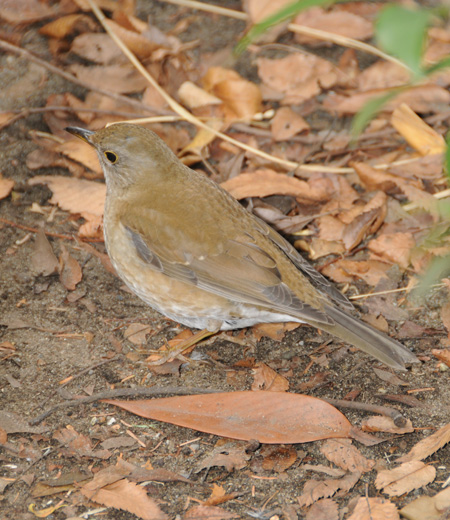 Is a winter bird fly to Japan to spent winter and native to areas in Ussuri river runs on the border of northeastern China and Russia and Korean Penninsula. Live in forests from flatlands to mountains and also at woody parks and fruit farms. Walk and jump around shady forests and hardly ever come out to open spaces. Hunt for earthworms and larvae from the fallen leaves layers and soils. The body color of male and female is almost the same and gray on the head and dark-greenish dark brown on the back. Gray on abdomen with distinct white center as the Japanese name Shirohara literally meaning white abdomen states. Chirp sounding like “cyo cyo cyo” and “twee” when they are about to fly. Fly back north in spring but some breed in Tsushima in Nagasaki prefecture.
Is a winter bird fly to Japan to spent winter and native to areas in Ussuri river runs on the border of northeastern China and Russia and Korean Penninsula. Live in forests from flatlands to mountains and also at woody parks and fruit farms. Walk and jump around shady forests and hardly ever come out to open spaces. Hunt for earthworms and larvae from the fallen leaves layers and soils. The body color of male and female is almost the same and gray on the head and dark-greenish dark brown on the back. Gray on abdomen with distinct white center as the Japanese name Shirohara literally meaning white abdomen states. Chirp sounding like “cyo cyo cyo” and “twee” when they are about to fly. Fly back north in spring but some breed in Tsushima in Nagasaki prefecture.
●Body Length about 25 cm
●Season November to March (Winter bird, fly to Japan in autumn and spend winter and fly away in spring.) -
Turdus eunomus (Dusky Thrush) Turdidae
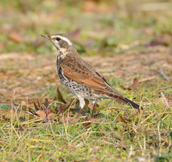
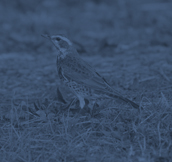 Turdus eunomus (Dusky Thrush) Turdidae
Turdus eunomus (Dusky Thrush) Turdidae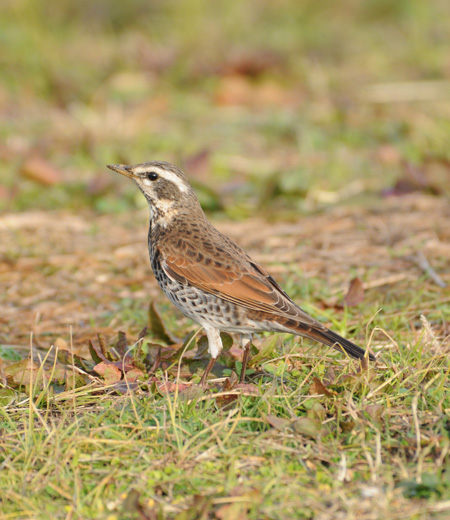 Come back to Japan in autumn in a large group from breeding ground in Siberia to spent winter. Spread throughout Japan and live in forests, croplands, riverbeds and parks and even at feeding stations at residence. Roost in woody forests and shrubs and live in a group right after they arrive Japan but most of them live alone in winter. Jump and walk on the ground and stop with holding their chest out. This species repeat these actions and hunt for preys. Feed on earthworms and larvae from picking them from fallen leaves and soils. Also feed on fruits of persimmons and pyracantha. In autumn, chirp sounding like “cu cu” repeatedly and “twee” while flying. Are in a group again in spring to go back north for breeding.
Come back to Japan in autumn in a large group from breeding ground in Siberia to spent winter. Spread throughout Japan and live in forests, croplands, riverbeds and parks and even at feeding stations at residence. Roost in woody forests and shrubs and live in a group right after they arrive Japan but most of them live alone in winter. Jump and walk on the ground and stop with holding their chest out. This species repeat these actions and hunt for preys. Feed on earthworms and larvae from picking them from fallen leaves and soils. Also feed on fruits of persimmons and pyracantha. In autumn, chirp sounding like “cu cu” repeatedly and “twee” while flying. Are in a group again in spring to go back north for breeding.
●Body length about 24 cm
●Season October to April (Winter bird, fly to Japan in autumn and spend winter and fly away in spring.) -
Tarsiger cyanurus (Red-flanked Bluechat) Muscicapidae
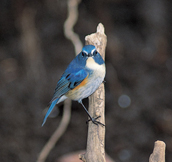
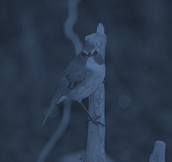 Tarsiger cyanurus (Red-flanked Bluechat) Muscicapidae
Tarsiger cyanurus (Red-flanked Bluechat) Muscicapidae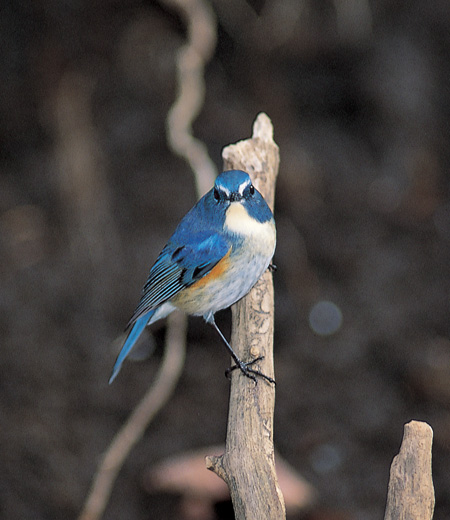 Male’s blue feathers from the head to the tail are very beautiful with striking orange on the side of abdomen. The body color of female is greenish brown on entire body. Change habitat on season and live in 1,500 meters high elevation areas from spring to summer for breeding and come down to low elevations including forests in Mt. Takao and woody parks in winter. Live alone and both male and female hold territory. Hunt for insects, centipedes and spiders and feed on nuts of trees in winter. The breeding season is from June to August. Male rest on higher branches and chirp sounding like “pi chuli hyo lo lo”. Build a cup-shaped nest with moss and fallen leaves at the root of fallen trees. Lay three to five eggs in a season.
Male’s blue feathers from the head to the tail are very beautiful with striking orange on the side of abdomen. The body color of female is greenish brown on entire body. Change habitat on season and live in 1,500 meters high elevation areas from spring to summer for breeding and come down to low elevations including forests in Mt. Takao and woody parks in winter. Live alone and both male and female hold territory. Hunt for insects, centipedes and spiders and feed on nuts of trees in winter. The breeding season is from June to August. Male rest on higher branches and chirp sounding like “pi chuli hyo lo lo”. Build a cup-shaped nest with moss and fallen leaves at the root of fallen trees. Lay three to five eggs in a season.
●Body Length about 14 cm
●Season November to March (wandering bird, bird that have different areas for breeding and spending winter)(未翻訳)鳴き声を聞く
-
Phoenicurus auroreus (Daurian Redstart) Muscicapidae
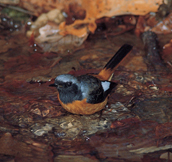
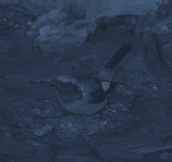 Phoenicurus auroreus (Daurian Redstart) Muscicapidae
Phoenicurus auroreus (Daurian Redstart) Muscicapidae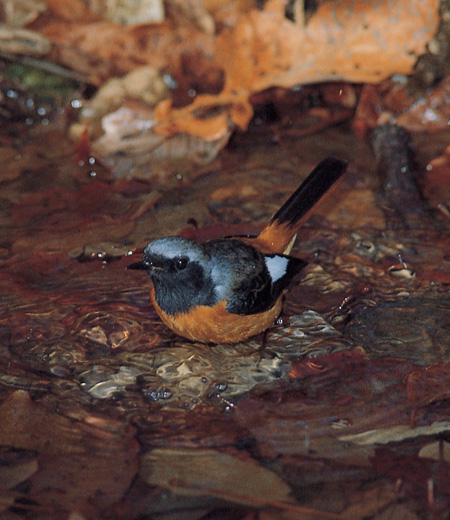 Come back to Japan in autumn from breeding ground in Siberia to spent winter. Live in open spaces including forests in low elevations, riverbeds and parks. The body color of male is silver on the head and the back of neck and distinct orange on abdomen. Stand on branches and stakes and chirp sounding like “he he” right after they arrive Japan to announce own territory. Also chirp sounding like “qua qua” after bowing and swing a tail. This sound is similar the sound hitting flints, hence the Japanese name hitaki for birds in muscicapidae family and it literally means to start a fire. Live alone and hunt for insects and spiders and also feed on fruits of Japanese spindles and pyracantha. Fly back north for breeding in early spring.
Come back to Japan in autumn from breeding ground in Siberia to spent winter. Live in open spaces including forests in low elevations, riverbeds and parks. The body color of male is silver on the head and the back of neck and distinct orange on abdomen. Stand on branches and stakes and chirp sounding like “he he” right after they arrive Japan to announce own territory. Also chirp sounding like “qua qua” after bowing and swing a tail. This sound is similar the sound hitting flints, hence the Japanese name hitaki for birds in muscicapidae family and it literally means to start a fire. Live alone and hunt for insects and spiders and also feed on fruits of Japanese spindles and pyracantha. Fly back north for breeding in early spring.
●Body Length about 14 cm
●Season October to April (Winter bird, fly to Japan in autumn and spend winter and fly away in spring.) -
Ficedula narcissina (Narcissus Flycatcher) Muscicapidae
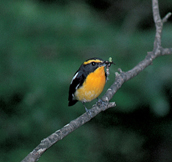
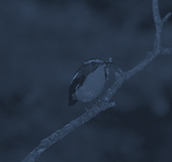 Ficedula narcissina (Narcissus Flycatcher) Muscicapidae
Ficedula narcissina (Narcissus Flycatcher) Muscicapidae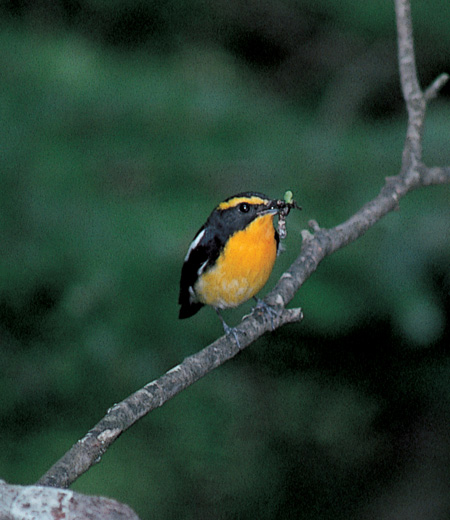 Fly back to Japan in spring from Southeast Asia. Found in forests with tall trees from flatlands to mountains. The body color of male is distinct yellow color from throat to chest as the Japanese name Kibitaki literally meaning yellow birds in muscicapidae family. The body color of female is subdued and greenish gray from the head to the back. Rest on branches and are not too active and feed on insects and spiders on branches and leaves. And sometimes fly insects in the air. The breeding season is from May to July. Male chirp in a different tones “pi co lo lo lo” and “tu ku tu ku o-shi” and also good at chirping like other birds. Build a nest with fallen leaves and moss in a hole of tree, ceiling of building and door pockets. Lay four to six eggs in a season. in spring and autumn, come down to parks in cities.
Fly back to Japan in spring from Southeast Asia. Found in forests with tall trees from flatlands to mountains. The body color of male is distinct yellow color from throat to chest as the Japanese name Kibitaki literally meaning yellow birds in muscicapidae family. The body color of female is subdued and greenish gray from the head to the back. Rest on branches and are not too active and feed on insects and spiders on branches and leaves. And sometimes fly insects in the air. The breeding season is from May to July. Male chirp in a different tones “pi co lo lo lo” and “tu ku tu ku o-shi” and also good at chirping like other birds. Build a nest with fallen leaves and moss in a hole of tree, ceiling of building and door pockets. Lay four to six eggs in a season. in spring and autumn, come down to parks in cities.
●Body Length about 15 cm
●Season April to September (Summer bird, fly to one area from spring to summer for breeding and fly back to southern areas in autumn.)(未翻訳)鳴き声を聞く
-
Cyanoptila cyanomelana (Blue-and-white Flycatcher) Muscicapidae
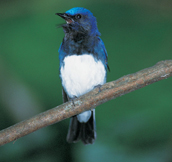
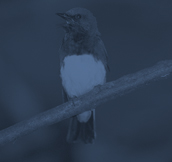 Cyanoptila cyanomelana (Blue-and-white Flycatcher) Muscicapidae
Cyanoptila cyanomelana (Blue-and-white Flycatcher) Muscicapidae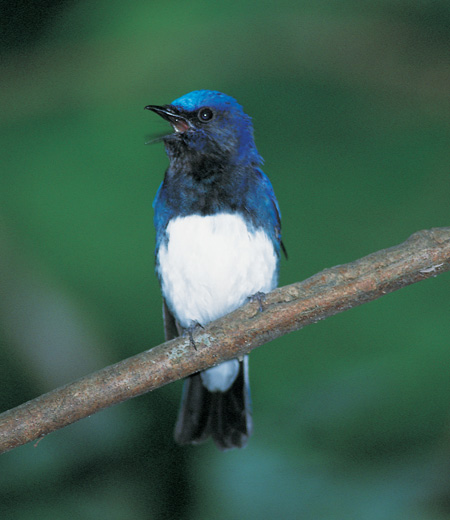 Fly back to Japan in spring from Southeast Asia. Live in forests in mountains and especially where it is close to ponds, lakes and stream. The body color of male is bright and shiny red feathers from head to the tail and female is light brown. Male chirp at the top of tall tree sounding like “pi lee lee, choo bee bee, gee gee” to announce own territory. The voice is very beautiful and this species, bush warbler and Japanese robin are designated as three birds in Japan with beautiful voices. Male have a several place for chirp and move routinely to each places and chirp. From May to July, build a deep cup-shaped nest with moss in the dip in a cliff and lay three to five eggs in a season. In autumn, fly back to the place where they spend winter.
Fly back to Japan in spring from Southeast Asia. Live in forests in mountains and especially where it is close to ponds, lakes and stream. The body color of male is bright and shiny red feathers from head to the tail and female is light brown. Male chirp at the top of tall tree sounding like “pi lee lee, choo bee bee, gee gee” to announce own territory. The voice is very beautiful and this species, bush warbler and Japanese robin are designated as three birds in Japan with beautiful voices. Male have a several place for chirp and move routinely to each places and chirp. From May to July, build a deep cup-shaped nest with moss in the dip in a cliff and lay three to five eggs in a season. In autumn, fly back to the place where they spend winter.
●Body Length about 16 cm
●Season April to August (Summer bird, fly to one area from spring to summer for breeding and fly back to southern areas in autumn.)(未翻訳)鳴き声を聞く
-
Motacilla cinerea (Grey Wagtail) Motacillidae
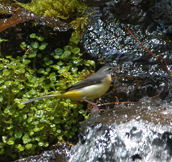
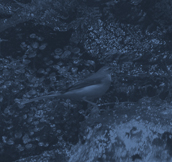 Motacilla cinerea (Grey Wagtail) Motacillidae
Motacilla cinerea (Grey Wagtail) Motacillidae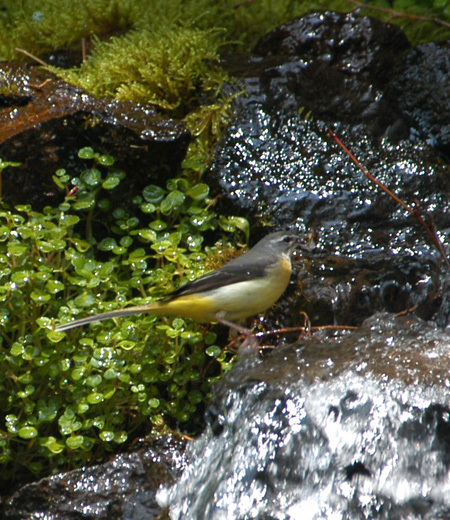 Live at waterside including rivers, ponds and lakes and prefer streams the best. Sometimes come to parks in cities. The body shape is skinny with long tail. The color of body for male and female is almost the same and gray on the back, yellow on the chest and white on throat but it turns to black on male during summer. Live alone except breeding season. Walk bustling while swinging tail up and down. Feed on aquatic insects hidden in water and under rocks. Male chirps sounding like “chi chi chi” on roofs or electric wires. Build a nest with twigs and fallen plants on space between rocks and ceilings and lay four to six eggs in a season.
Live at waterside including rivers, ponds and lakes and prefer streams the best. Sometimes come to parks in cities. The body shape is skinny with long tail. The color of body for male and female is almost the same and gray on the back, yellow on the chest and white on throat but it turns to black on male during summer. Live alone except breeding season. Walk bustling while swinging tail up and down. Feed on aquatic insects hidden in water and under rocks. Male chirps sounding like “chi chi chi” on roofs or electric wires. Build a nest with twigs and fallen plants on space between rocks and ceilings and lay four to six eggs in a season.
●Body Length about 20 cm
●Season January to December (resident bird, bird that stay in the same area all year round, and wandering bird, bird that have different areas for breeding and spending winter)(未翻訳)鳴き声を聞く
-
Motacilla grandis (Japanese Wagtail) Motacillidae
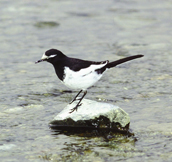
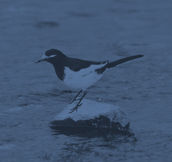 Motacilla grandis (Japanese Wagtail) Motacillidae
Motacilla grandis (Japanese Wagtail) Motacillidae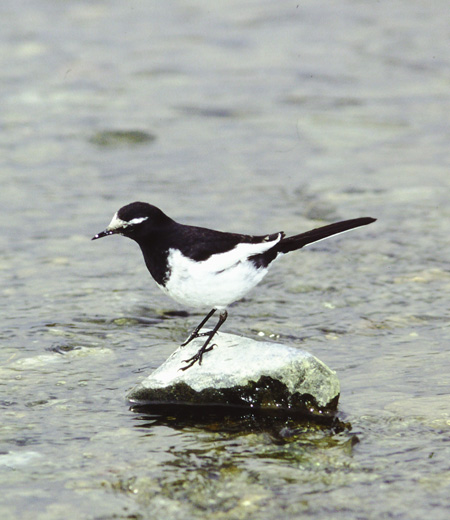 Is a family of wagtail native to Japan. Live near upstream and shoreside of ponds or lakes. The body color resembles white wagtail and but black face with white eyebrow-like line is different. Body color of male and female is almost the same but male have darker shades. Stay alone or in pairs during daytime but are in a small group at night and roost in trees or ceilings. Swing tail up and own and walk around with a quick pace and feed on earthworms and insects. The breeding season is from March to July. Male chirps “choc ho joy joy joy”. Build a cup-shaped nest with fallen leaves in dip in riverbank and space between buildings. Lay four to five eggs in a season. After nestling, live in pairs to spent winter.
Is a family of wagtail native to Japan. Live near upstream and shoreside of ponds or lakes. The body color resembles white wagtail and but black face with white eyebrow-like line is different. Body color of male and female is almost the same but male have darker shades. Stay alone or in pairs during daytime but are in a small group at night and roost in trees or ceilings. Swing tail up and own and walk around with a quick pace and feed on earthworms and insects. The breeding season is from March to July. Male chirps “choc ho joy joy joy”. Build a cup-shaped nest with fallen leaves in dip in riverbank and space between buildings. Lay four to five eggs in a season. After nestling, live in pairs to spent winter.
●Body Length about 21 cm
●Season January to December (resident bird, bird that stay in the same area all year round.) -
Eophona personata (Japanese Grosbeak) Fringillidae
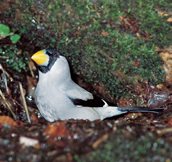
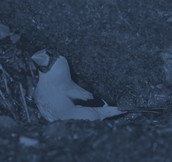 Eophona personata (Japanese Grosbeak) Fringillidae
Eophona personata (Japanese Grosbeak) Fringillidae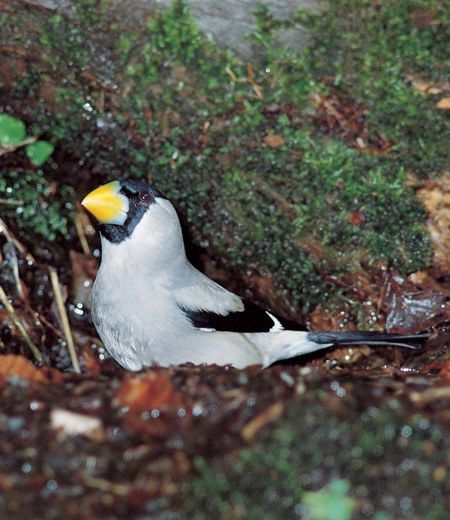 Live in forests from flatlands to low elevations and found in Mt. Takao throughout a year. The color of body for male and female is almost the same and black head, long tail and thick and large yellow bills are distinct. Chirp like whistles but also sounds like “tsu kee hee ho shi”, thus it is sometimes called as Japanese paradise flycatcher. Mainly live on trees and feed on soft fruits and buds of trees including aphananthe and Chinese sumac. Sometimes jump on the ground and feed on seeds of plants. Hard seeds are cracked using bills. The breeding season is from mid May to early July. Build a cup-shaped nest with stems and roots on branches of tall trees and lay three to four eggs in a season. From autumn to winter, come down to woods and croplands near residential areas to hunt for preys.
Live in forests from flatlands to low elevations and found in Mt. Takao throughout a year. The color of body for male and female is almost the same and black head, long tail and thick and large yellow bills are distinct. Chirp like whistles but also sounds like “tsu kee hee ho shi”, thus it is sometimes called as Japanese paradise flycatcher. Mainly live on trees and feed on soft fruits and buds of trees including aphananthe and Chinese sumac. Sometimes jump on the ground and feed on seeds of plants. Hard seeds are cracked using bills. The breeding season is from mid May to early July. Build a cup-shaped nest with stems and roots on branches of tall trees and lay three to four eggs in a season. From autumn to winter, come down to woods and croplands near residential areas to hunt for preys.
●Body Length about 23 cm
●Season January to December (resident bird, bird that stay in the same area all year round, and wandering bird, bird that have different areas for breeding and spending winter)(未翻訳)鳴き声を聞く
-
Emberiza rustica (Rustic Bunting) Emberizidae
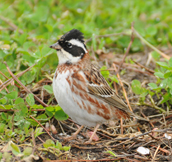
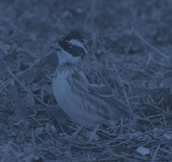 Emberiza rustica (Rustic Bunting) Emberizidae
Emberiza rustica (Rustic Bunting) Emberizidae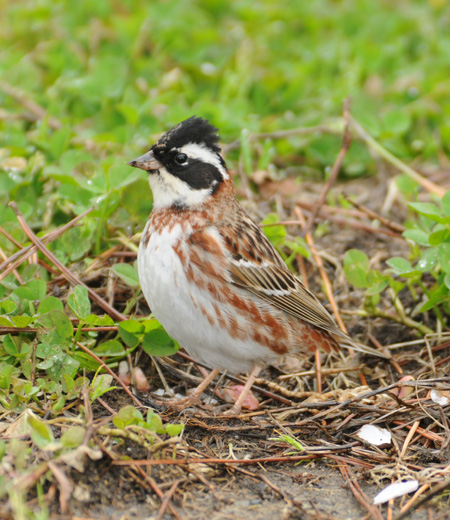 Fly back to Japan in autumn from breeding ground in Siberia. The Japanese name Kashira-daka literally meaning tall head was named because the feathers on heads are upright and looks tall. It also looks like Mohican haircut. Is very similar to Siberian meadow bunting but it is easy to identify the difference by looking at their heads. In winter, head and cheeks are brown in winter but in summer head is black with white stripe over the eye. Found in riverbeds, croplands and woods from flatlands to mountains. Live in a small group. Gather at the open space near forests and jump around and feed on seeds of plants. When surprised, jump to branches and upright feathers on the head. Chirp sounding like “chi” and “pee chuku pee chuku” in spring.
Fly back to Japan in autumn from breeding ground in Siberia. The Japanese name Kashira-daka literally meaning tall head was named because the feathers on heads are upright and looks tall. It also looks like Mohican haircut. Is very similar to Siberian meadow bunting but it is easy to identify the difference by looking at their heads. In winter, head and cheeks are brown in winter but in summer head is black with white stripe over the eye. Found in riverbeds, croplands and woods from flatlands to mountains. Live in a small group. Gather at the open space near forests and jump around and feed on seeds of plants. When surprised, jump to branches and upright feathers on the head. Chirp sounding like “chi” and “pee chuku pee chuku” in spring.
●Body Length about 15 cm
●Season November to March (Winter bird, fly to Japan in autumn and spend winter and fly away in spring.) -
Emberiza personata (Black-faced Bunting) Emberizidae
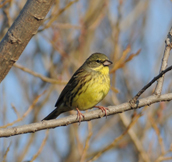
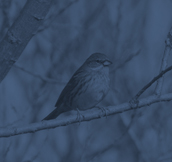 Emberiza personata (Black-faced Bunting) Emberizidae
Emberiza personata (Black-faced Bunting) Emberizidae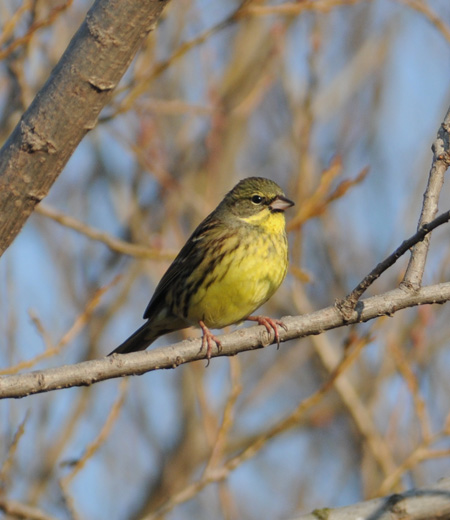 Change habitat by season. In autumn fly down south for warmer climate and fly to Mt. Takao as a winter bird (fly to Japan in autumn and spend winter and fly away in spring). Birds in the same family with Siberian meadow bunting have brown body but this species is yellowish. Found in shady woods, bamboo shrubs and reed bushes. Live in a small group. Walk and jump around and feed on seeds of plants, insects and spiders. The breeding season is from May to August. Build a cup-shaped nest with dead leaves and bent stems on branches close to the ground. Lay four to five eggs in a season. In winter, come down to plants at parks in cities for preys.
Change habitat by season. In autumn fly down south for warmer climate and fly to Mt. Takao as a winter bird (fly to Japan in autumn and spend winter and fly away in spring). Birds in the same family with Siberian meadow bunting have brown body but this species is yellowish. Found in shady woods, bamboo shrubs and reed bushes. Live in a small group. Walk and jump around and feed on seeds of plants, insects and spiders. The breeding season is from May to August. Build a cup-shaped nest with dead leaves and bent stems on branches close to the ground. Lay four to five eggs in a season. In winter, come down to plants at parks in cities for preys.
●Body Length about 16 cm
●Season November to April (wandering bird, bird that have different areas for breeding and spending winter)(未翻訳)鳴き声を聞く
-
Emberiza variabilis (Grey Bunting) Emberizidae
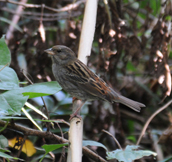
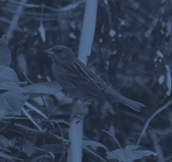 Emberiza variabilis (Grey Bunting) Emberizidae
Emberiza variabilis (Grey Bunting) Emberizidae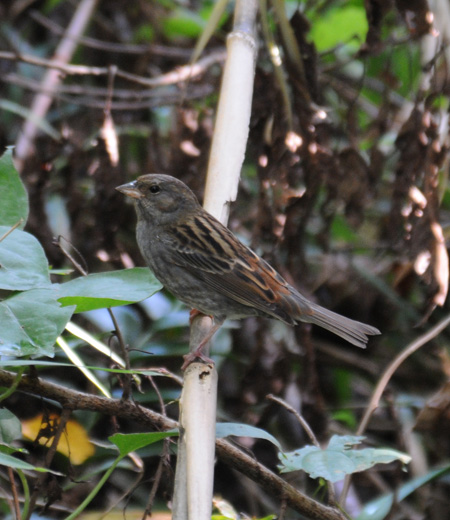 Live in flatlands and mountains in Hokkaido and northern parts of Honshu from spring to summer, but come down south in autumn. Fly to Mt. Takao as a winter birds (fly to Japan in autumn and spend winter and fly away in spring). The body color of male is dark gray and female is black brown, hence the Japanese name Kuroji literally meaning black base color. Prefer shady and dark environment and jump around sasa shrubs or bushes of plants. Is a very careful bird, even if they come out to forest trails but hide immediately in bushes when sensing danger. Feed on seeds of plants and also insects and spiders. The breeding season is June. Male come out to bright and open space on branch and chirp “ho-I ci ci ci”. Build a cup-shaped nest with fallen leaves in bamboo shrubs and lay three to five eggs.
Live in flatlands and mountains in Hokkaido and northern parts of Honshu from spring to summer, but come down south in autumn. Fly to Mt. Takao as a winter birds (fly to Japan in autumn and spend winter and fly away in spring). The body color of male is dark gray and female is black brown, hence the Japanese name Kuroji literally meaning black base color. Prefer shady and dark environment and jump around sasa shrubs or bushes of plants. Is a very careful bird, even if they come out to forest trails but hide immediately in bushes when sensing danger. Feed on seeds of plants and also insects and spiders. The breeding season is June. Male come out to bright and open space on branch and chirp “ho-I ci ci ci”. Build a cup-shaped nest with fallen leaves in bamboo shrubs and lay three to five eggs.
●Body Length about 17 cm
●Season November to March (wandering bird, bird that have different areas for breeding and spending winter)(未翻訳)鳴き声を聞く
-
Macaca fuscata (Japanese Macaque) Cercopithecidae
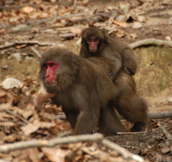
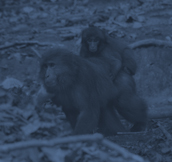 Macaca fuscata (Japanese Macaque) Cercopithecidae
Macaca fuscata (Japanese Macaque) Cercopithecidae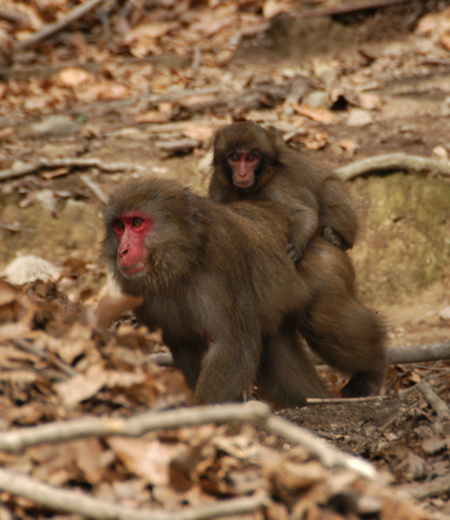 Main region: Honshu, Shikoku and Kyushu. The ones live in Shimokita peninsula in Aomori prefectures are widely known as the World’s northernmost monkeys (Hokugen-no-saru in Japanese). Found in forests in mountains. In Mt. Takao, there are wild species and sometimes found them in groups at mountain trails. Red face and red bottom is very distinctive. Normally live in large groups called troop consists of several males and hundreds of female and children. Thus, there is a possibility of finding many monkeys when encountering just one monkey. Are omnivores and mainly feed on vegetables. Feed on leaves and sprouts of plants, fruits and insects and even barks of trees in winter when there are limited foods. Have cheek pouches, where food is stuffed temporarily.
Main region: Honshu, Shikoku and Kyushu. The ones live in Shimokita peninsula in Aomori prefectures are widely known as the World’s northernmost monkeys (Hokugen-no-saru in Japanese). Found in forests in mountains. In Mt. Takao, there are wild species and sometimes found them in groups at mountain trails. Red face and red bottom is very distinctive. Normally live in large groups called troop consists of several males and hundreds of female and children. Thus, there is a possibility of finding many monkeys when encountering just one monkey. Are omnivores and mainly feed on vegetables. Feed on leaves and sprouts of plants, fruits and insects and even barks of trees in winter when there are limited foods. Have cheek pouches, where food is stuffed temporarily.
●Body Length about 47 to 70 cm
●Season All year -
Sus scrofa leucomystax (Japanese Wild Boar) Suidae
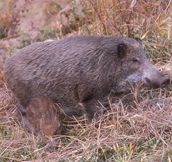
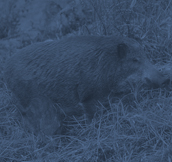 Sus scrofa leucomystax (Japanese Wild Boar) Suidae
Sus scrofa leucomystax (Japanese Wild Boar) Suidae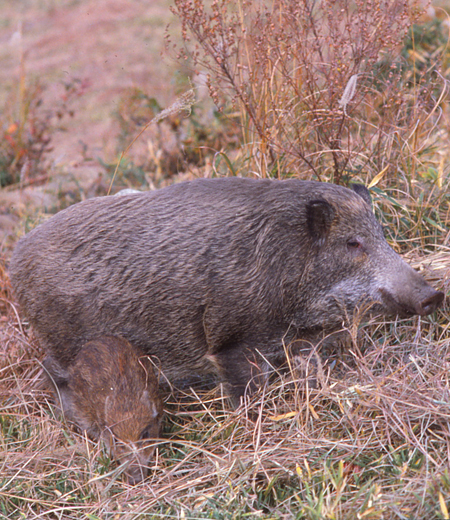 Main region: Honshu (West of Kanto area), Shikoku and Kyushu. Found in woodlands in satoyama (satoyama is where residential area and woodlands coexists in rural area) and forests in mountains. The color of hair is gray-brown to light black or brown. The wild boar piglets have stripe patterns and often called as “Uribo (wild boar piglet)”. Are active at night. Dig up the ground with snouts and feed on roots of plants, insects and earthworms. Their sense of smell is well developed which enable them to look for potatoes in soils with snout. Have unique habit called Nuta (nota)-uchi literally meaning to wallow in muds. This is to scrape off parasites by bathing in the muds or swampy areas they created. In Mt. Takao, sometimes these swampy areas where wild boars wallowed could be found near mountain trails.
Main region: Honshu (West of Kanto area), Shikoku and Kyushu. Found in woodlands in satoyama (satoyama is where residential area and woodlands coexists in rural area) and forests in mountains. The color of hair is gray-brown to light black or brown. The wild boar piglets have stripe patterns and often called as “Uribo (wild boar piglet)”. Are active at night. Dig up the ground with snouts and feed on roots of plants, insects and earthworms. Their sense of smell is well developed which enable them to look for potatoes in soils with snout. Have unique habit called Nuta (nota)-uchi literally meaning to wallow in muds. This is to scrape off parasites by bathing in the muds or swampy areas they created. In Mt. Takao, sometimes these swampy areas where wild boars wallowed could be found near mountain trails.
●Body Length about 140 cm
●Season All year -
Meles anakuma (Japanese Badger) Mustelidae
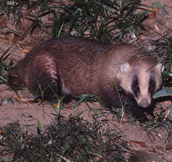
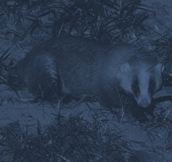 Meles anakuma (Japanese Badger) Mustelidae
Meles anakuma (Japanese Badger) Mustelidae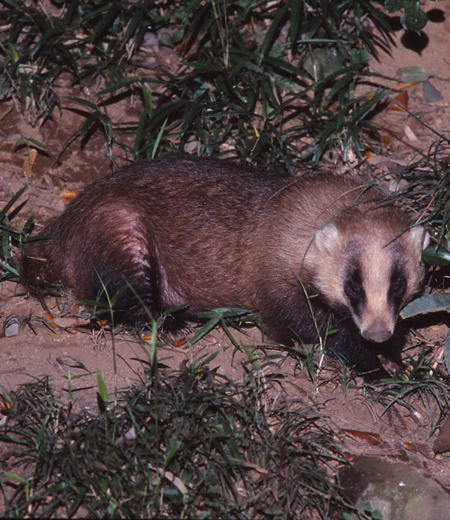
Main region: Honshu, Shikoku and Kyushu. Found in forests from low elevations to mountains. The other name is Mujina in Japanese but often mixed up with raccoon dog as they are also called as Mujina in some places in Japan. Both badger and raccoon dog are very similar in appearance and habit, however raccoon dog is in canidae family that is not a closely related species. The Japanese name is Nihon-anaguma has the word bear (guma) but they are not in the same family with bears. Are good at digging holes as Anaguma literally meaning hall digging bear states. Create 10 to 20 meters long tunnel in underground and lairs by using sharp nails. Rest in lairs during daytime and become active at night. Walk around mountains and feed on acorns, fruits, earthworms, insects, frogs and snails.
●Body Length about 44 to 68 cm
●Season April to November -
Sciurus lis (Japanese Squirrel) Japanese Dwarf Flying Squirrel
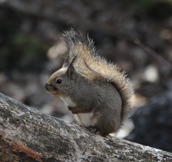
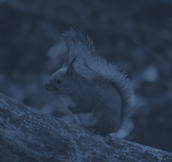 Sciurus lis (Japanese Squirrel) Japanese Dwarf Flying Squirrel
Sciurus lis (Japanese Squirrel) Japanese Dwarf Flying Squirrel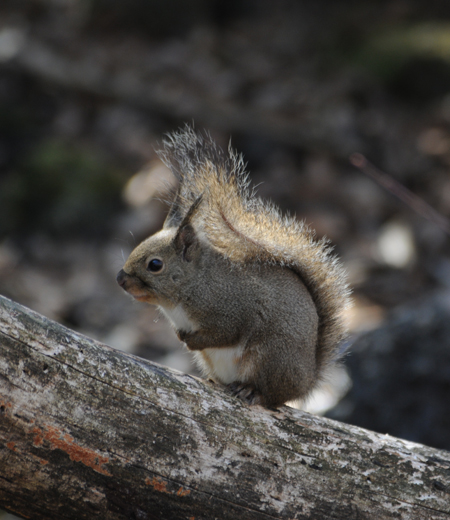 Main region: Honshu, Shikoku, and Kyushu. Rarely seen in Kyushu and Chugoku region due to deteriorated habitat. Found in forests in low elevations. Live mostly on trees but often come down to the ground. Create spherical shaped dreys with small branches and moss at spaces between branches. Are active in early morning and late afternoon but sometimes found at mountain trails. Feed on nuts and buds of trees and store a number of acorns in soils for the foods during winter. Have distinct long tails and look very cute when holding acorns and walnuts to eat. Sometimes, they jump more than 10 meters and move from branches to branches.
Main region: Honshu, Shikoku, and Kyushu. Rarely seen in Kyushu and Chugoku region due to deteriorated habitat. Found in forests in low elevations. Live mostly on trees but often come down to the ground. Create spherical shaped dreys with small branches and moss at spaces between branches. Are active in early morning and late afternoon but sometimes found at mountain trails. Feed on nuts and buds of trees and store a number of acorns in soils for the foods during winter. Have distinct long tails and look very cute when holding acorns and walnuts to eat. Sometimes, they jump more than 10 meters and move from branches to branches.
●Body Length about 20 cm
●Season all year round -
Petaurista leucogenys (Japanese Giant Flying Squirrel) Japanese Dwarf Flying Squirrel
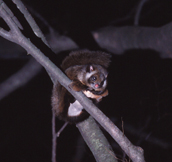
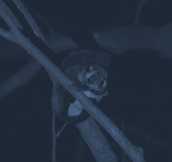 Petaurista leucogenys (Japanese Giant Flying Squirrel) Japanese Dwarf Flying Squirrel
Petaurista leucogenys (Japanese Giant Flying Squirrel) Japanese Dwarf Flying Squirrel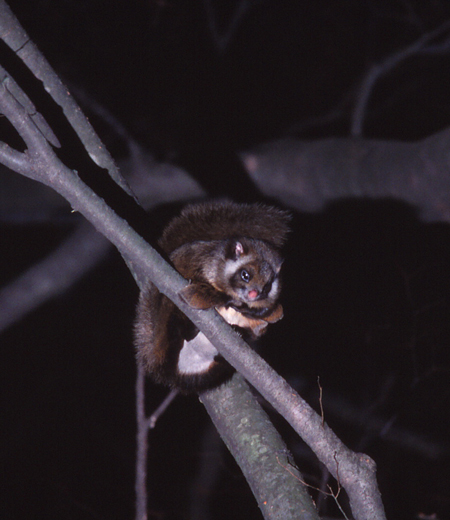 Main region: Honshu, Shikoku and some part of Kyushu. Found in forests from flatlands to mountains. Are well known as gliding mammals. Glide like a glider from a tree to a tree by stretching wings covering their body and feed on leaves, buds, flowers and seeds of trees. With well-developed gliding ability, glide over 100 meters. Live mostly on trees and rest in a nest created in hollows and holes of big trees during daytime. Become active after sunset and hunt for prey. In Mt. Takao, often found around Yakuoin and a tour with guide is organized.
Main region: Honshu, Shikoku and some part of Kyushu. Found in forests from flatlands to mountains. Are well known as gliding mammals. Glide like a glider from a tree to a tree by stretching wings covering their body and feed on leaves, buds, flowers and seeds of trees. With well-developed gliding ability, glide over 100 meters. Live mostly on trees and rest in a nest created in hollows and holes of big trees during daytime. Become active after sunset and hunt for prey. In Mt. Takao, often found around Yakuoin and a tour with guide is organized.
●Body Length about 34 to 50 cm
●Season All year(未翻訳)鳴き声を聞く
-
Pteromys momonga (Japanese Dwarf Flying Squirrel) Japanese Dwarf Flying Squirrel
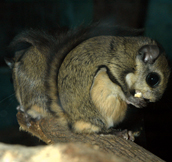
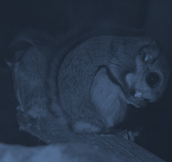 Pteromys momonga (Japanese Dwarf Flying Squirrel) Japanese Dwarf Flying Squirrel
Pteromys momonga (Japanese Dwarf Flying Squirrel) Japanese Dwarf Flying Squirrel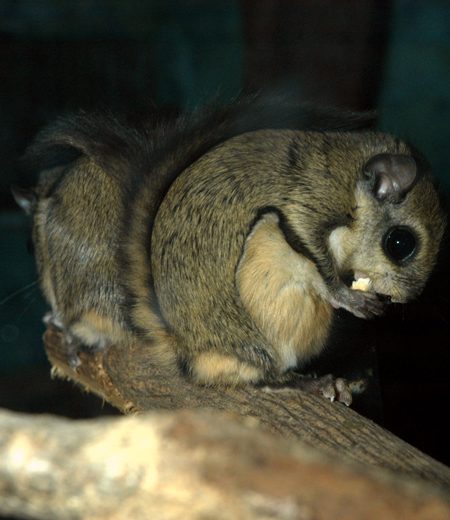 Main region: Honshu, Shikoku and Kyushu. Found in forests in mountains. Have distinct big round eyes and glide by stretching wings like giant flying squirrels. Flight distance is normally 20 to 30 meters but sometimes glide over 100 meters and their flight ability is like giant flying squirrels. Live mostly on trees and become active at night and feed on leaves, buds, fruits, seeds and barks of trees by gliding from trees to trees. The body size is a lot smaller than giant flying squirrels and they are twice as large in body length and 10 times heavier in weight.
Main region: Honshu, Shikoku and Kyushu. Found in forests in mountains. Have distinct big round eyes and glide by stretching wings like giant flying squirrels. Flight distance is normally 20 to 30 meters but sometimes glide over 100 meters and their flight ability is like giant flying squirrels. Live mostly on trees and become active at night and feed on leaves, buds, fruits, seeds and barks of trees by gliding from trees to trees. The body size is a lot smaller than giant flying squirrels and they are twice as large in body length and 10 times heavier in weight.
●Body Length about 14 to 20 cm
●Season All year -
Apodemus speciosus (Large Japanese Field Mouse) Muridae
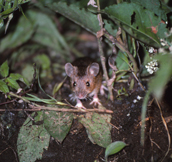
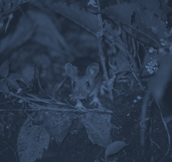 Apodemus speciosus (Large Japanese Field Mouse) Muridae
Apodemus speciosus (Large Japanese Field Mouse) Muridae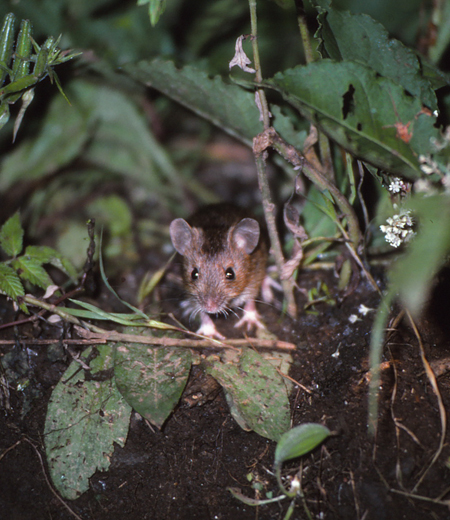 Main region: Hokkaido to Kyushu. This species and small Japanese field mouse are fields mouse native to Japan found in mountains throughout Japan. Small Japanese field mouse live on trees but this species live on ground and do not climb trees. Dig tunnels and nest underground. Feed on fallen seeds, rhizomes and small insects. Tends to store dozens of times the volumes of nuts and seeds including acorns typically consume. The body hair is red-brown as the Japanese name Aka-nezumi literally meaning red-colored rat state. Have distinct big round eyes but are rarely seen during the day because they are mostly active at night. Hind legs are well developed and could walk a couple of kilometers.
Main region: Hokkaido to Kyushu. This species and small Japanese field mouse are fields mouse native to Japan found in mountains throughout Japan. Small Japanese field mouse live on trees but this species live on ground and do not climb trees. Dig tunnels and nest underground. Feed on fallen seeds, rhizomes and small insects. Tends to store dozens of times the volumes of nuts and seeds including acorns typically consume. The body hair is red-brown as the Japanese name Aka-nezumi literally meaning red-colored rat state. Have distinct big round eyes but are rarely seen during the day because they are mostly active at night. Hind legs are well developed and could walk a couple of kilometers.
●Body Length about 8 to 14 cm
●Season All year -
Apondemus argenteus (Small Japanese Field Mouse) Muridae
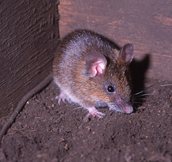
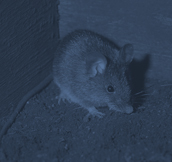 Apondemus argenteus (Small Japanese Field Mouse) Muridae
Apondemus argenteus (Small Japanese Field Mouse) Muridae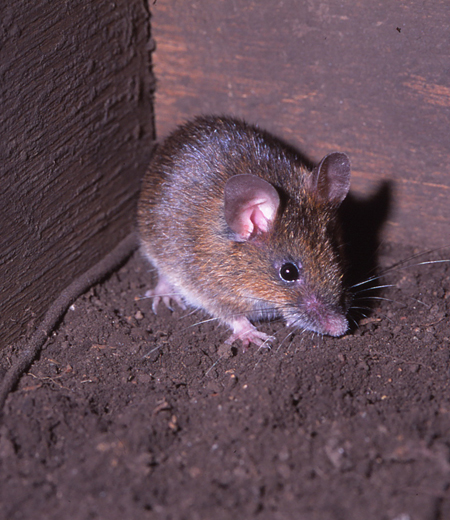 Main region: Throughout Japan including Hokkaido, Honshu, Shikoku, Kyushu, Sado Island, Miyake Island and Yaku Island. Field mouse native to Japan found in forests from low to high elevations. Very similar to large Japanese field mouse but the body size is a lot smaller and tail is longer than the length from the head to the ramp. The large Japanese field mouse live on ground but this species live mostly on trees as their body weight is lighter and have flexible tails and thin leg fingers. Balance the body with long tails and move fast even on vines and thin branches. Are semi-arboreal and live up to 10 meters high and sometimes create nests on trees. Feed on acorns, seeds and insects.
Main region: Throughout Japan including Hokkaido, Honshu, Shikoku, Kyushu, Sado Island, Miyake Island and Yaku Island. Field mouse native to Japan found in forests from low to high elevations. Very similar to large Japanese field mouse but the body size is a lot smaller and tail is longer than the length from the head to the ramp. The large Japanese field mouse live on ground but this species live mostly on trees as their body weight is lighter and have flexible tails and thin leg fingers. Balance the body with long tails and move fast even on vines and thin branches. Are semi-arboreal and live up to 10 meters high and sometimes create nests on trees. Feed on acorns, seeds and insects.
●Body Length about 6 to 10 cm
●Season All year
